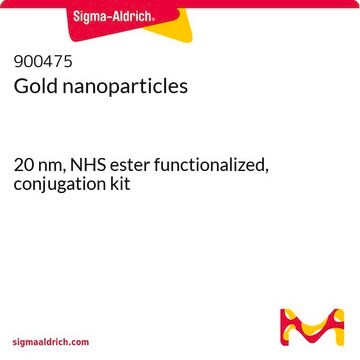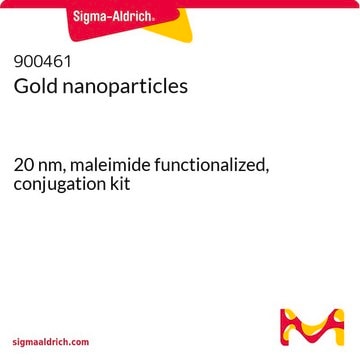The color change of AuNPs when mixed with NaCl is typically due to the aggregation of AuNPs. However, this product contains citrate buffer as a stabilizer, so a small amount of NaCl will not lead to aggregation. Increasing the amount of NaCl or performing a solvent exchange to remove the citrate buffer may induce a color change, but this is not recommended as the aggregated AuNPs may not be able to be re-dispersed. Unfortunately, no protocol is available to functionalize the AuNPs.
741965
Gold nanoparticles
20 nm diameter, OD 1, stabilized suspension in citrate buffer
Synonym(s):
Au NP, Gold Colloid
About This Item
Recommended Products
Quality Level
form
nanoparticles
suspension
contains
Proprietary Surfactant as stabilizer
concentration
~6.54E+11 particles/mL
OD
1
diameter
20 nm
λmax
518-522 nm
PDI
<0.2
storage temp.
2-8°C
SMILES string
[Au]
InChI
1S/Au
InChI key
PCHJSUWPFVWCPO-UHFFFAOYSA-N
Looking for similar products? Visit Product Comparison Guide
General description
Application
- neutrophil labeling for monitoring the effect of different drugs[7]
- immobilization of proteins for biosensor applications[8]
- nano-carrier for drug delivery system for the release of hydrophobic drugs.[4]
This material is highly monodisperse (<12% variability in size and shape), and provides significantly improved surface reactivity. Applications include Surface Enhanced Raman Lables, Sensing/Detection, Biological Targeting, Plasmonics and Electronics.
Legal Information
Storage Class Code
12 - Non Combustible Liquids
WGK
nwg
Flash Point(F)
Not applicable
Flash Point(C)
Not applicable
Choose from one of the most recent versions:
Already Own This Product?
Find documentation for the products that you have recently purchased in the Document Library.
Customers Also Viewed
Articles
Steven J. Oldenburg, Ph.D. provides an overview of lateral flow diagnostic assays and discusses the use of ultra-bright reporter particles based on the unique optical properties of gold nanoshells that significantly increase the sensitivity of lateral flow immunoassays.
Steven J. Oldenburg, Ph.D. provides an overview of lateral flow diagnostic assays and discusses the use of ultra-bright reporter particles based on the unique optical properties of gold nanoshells that significantly increase the sensitivity of lateral flow immunoassays.
Sustainable energy sources with high production efficiency are crucial for meeting increasing energy demand.
Steven J. Oldenburg, Ph.D. provides an overview of lateral flow diagnostic assays and discusses the use of ultra-bright reporter particles based on the unique optical properties of gold nanoshells that significantly increase the sensitivity of lateral flow immunoassays.
-
The AuNPs in citrate do not change color when with NaCl. What can I do? Do you have any recommendation of what protocol can I use to functionalize citrate AuNPs 20nm?
1 answer-
Helpful?
-
-
What is the molarity of this solution (ref: 741965)?"
1 answer-
The concentration for this product is listed as ~6.54E+11 particles/mL. The concentration in g/mol is not determined.
Helpful?
-
-
My solution of 5nm gold nanoparticles has turned from red to purple. This would indicate aggregation. What caused this and how can I reverse the aggregation? The nanoparticles are stored in a fridge at 5 degrees C.
1 answer-
The information below regarding the color change and aggregation is provided by the manufacturer:
The gold nanoparticle solution turns violet when I add salt-containing buffer. Why is that?
Due to repulsive forces arising from the surface charge of gold nanoparticles, an energy barrier must be overcome for individual particles to interact.
When no (or small) amounts of electrolytes such as NaCl are present, this energy barrier is too strong for interaction to occur between particles. However, upon the addition of NaCl, this energy barrier is reduced allowing the gold nanoparticles to interact and aggregate. This aggregation causes a phenomenon called surface-plasmon coupling which changes the adsorption maximum of light to a higher wavelength resulting in a change in the color of the solution.Gold Nanoparticle Aggregation
The aggregation state of gold nanoparticles has an effect on their optical properties. This fact can be used to monitor gold nanoparticle stability, both over time, and upon the addition of salt-containing buffers, which at high enough concentrations cause particle aggregation, figure 5. The red-shift in absorption maximum caused by aggregation, or particles in close proximity, has successfully been utilized in many assays as a detection mechanism.See the image below for details on the effects of aggregation on color change and wavelength.
To discuss this further, please we kindly ask you to navigate to the link https://www.sigmaaldrich.com/techservice and click on "Report Product Issues" under the Products Section with all the required information so that a member of our team can reach out to you to assist further. Thank you.
Helpful?
-
-
Which technique is used for the synthesis of these Gold nanoparticles?
1 answer-
This product has a quality level 100. The preparation and synthesis is proprietary for products with a quality level under 400.
Helpful?
-
-
Why does my gold nanoparticle solution turn violet when I add salt containing buffer?
1 answer-
Due to repulsive forces arising from the surface charge of gold nanoparticles, an energy barrier must be overcome for individual particles to interact. When no (or small) amounts of electrolytes such as NaCl is present, this energy barrier is too strong for interaction to occur between particles. However, upon addition of NaCl this energy barrier is reduced allowing the gold nanoparticles to interact and aggregate. This aggregation causes a phenomenon called surface-plasmon coupling which changes the adsorption maximum of light to a higher wavelength resulting in a change in color of the solution.
Helpful?
-
-
How does the storage temperature relate to shipping conditions?
1 answer-
The storage conditions that a Sigma-Aldrich catalog and label recommend for products are deliberately conservative. For many products, long-term storage at low temperatures will increase the time during which they are expected to remain in specification and therefore are labeled accordingly. Where short-term storage, shipping time frame, or exposure to conditions other than those recommended for long-term storage will not affect product quality, Sigma-Aldrich will ship at ambient temperature. The products sensitive to short-term exposure to conditions other than their recommended long-term storage are shipped on wet or dry ice. Ambient temperature shipping helps to control shipping costs for our customers. At any time, our customers can request wet- or dry-ice shipment, but the special handling is at customer expense if our product history indicates that the product is stable for regular shipment.
Helpful?
-
-
Can the Gold nanoparticles be frozen?
1 answer-
No, the Gold nanoparticles should not be frozen. If frozen, the gold nanoparticles will irreversibly aggregate, turning the solution clear.
Helpful?
-
-
What is the Department of Transportation shipping information for this product?
1 answer-
Transportation information can be found in Section 14 of the product's (M)SDS.To access the shipping information for this material, use the link on the product detail page for the product.
Helpful?
-
-
Which gold nanoparticle size should I choose for my application?
1 answer-
The size of gold nanoparticle to use is very depandent upon the intended application. Generally, smaller particles offer better sensitivity in applications such as immunogold labeling due to less steric hindrance and the ability to bind more gold nanoparticles to the desired target. Small gold nanoparticles are less visible than larger particles, however, which must also be taken into account.As an application example, particles with a size between 30-50nm are particularly useful for the development of rapid tests such as lateral flow assays.
Helpful?
-
-
How do you attach gold nanoparticles to peptides and peptide conjugates?
1 answer-
To view information on how to attach gold nanoparticles to peptides and peptide conjugates, please view the information in the reference - Rosenthal, S. J. and Wright, D. W. (Eds.). (2005), p. 91-92. NanoBiotechnology Protocols. New Jersey. Humana Press.
Helpful?
-
Active Filters
Our team of scientists has experience in all areas of research including Life Science, Material Science, Chemical Synthesis, Chromatography, Analytical and many others.
Contact Technical Service




